Becky's Journal - August 2 - August 8
On the Road: Chicken, Dawson City, and Whitehorse
Relaxing
in Tok – Sunday, August 2, 2009
Tok marks the beginning of our slow meandering journey home. We went through Tok, at the crossroads of the Glenn Highway and the Alaska Highway, on our original route north. At that time, knowing we’d be back through Tok later, we chose to breeze through town on to Delta Junction, the terminus of the Alaska Highway.
We arrived in Tok Friday for some catch-up and relaxing time. Saturday we got laundry done and the trailer cleaned and visited the Tok visitors’ center, where we picked up some information on our next stops. This morning, we worshipped at small Faith Chapel, spoke with my parents, and Andrew and Noah, and Matthew (and Tasha and Asher on speakerphone). Then we went grocery shopping.
Tomorrow we head to Chicken, and then across the Top of the World Highway to Dawson (often referred to as Dawson City to prevent confusion with Dawson Creek, the start of the Alaska Highway.) Then we will take the Klondike Loop through gold country back to Whitehorse.
Downtown
Chicken – Monday, August 03, 2009
Today we drove from Tok north up the 1950’s era Taylor Highway to Chicken, a wide spot in the road where gold was discovered in 1896. Chicken, named by gold miners who couldn’t spell Ptarmigan, the Alaska state bird on which they feasted, is enjoying a bit of a tourist resurgence. Along with a tin-roofed ghost town, present-day Chicken features three summer businesses, each of which offers several different tourist enterprises.
The Town of Chicken, where we are dry camped, has a gas station, RV park and cabins, three-hole golf course with “country club,” gift shop, and offers tours of the historic town, which we hope to take tomorrow morning. This afternoon, we also checked out Chicken Gold Camp, which offers a café, an RV park and cabins, a gift shop, gold panning, and tours of a historic gold dredge. The third enterprise, Beautiful Downtown Chicken, has a mercantile, café, salmon bake, and saloon. These businesses, I’m sure, continue mining (the pockets of tourists) today, but we enjoyed the stop.
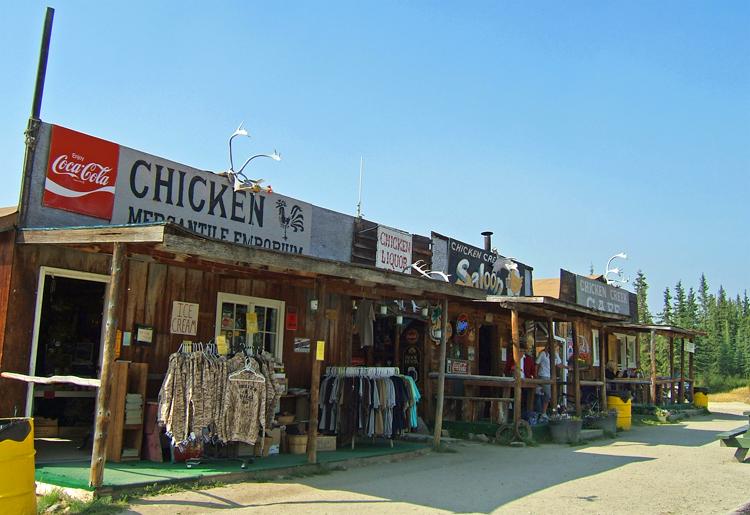
We also visited the post office built in 1903. Mail is delivered twice a week, and we chatted with the postmistress who has relatives in California’s Gold Country. Chicken, according to the Milepost guide, has a population of 21 in summer and 6 in winter.
The drive from Tok today was hazy due to smoke from wildfires. Locals tell us that summers in Alaska are marked by hundreds of wildfires – mostly sparked by lightening. Winters, although cold, mean the disappearances of the pesky mosquitoes and black flies. The scenery today featured the charred remains of trees burned in a 2004 fire – one that burned 1.3 million acres. Distant views often appeared tinged with a blanket of pink – fireweed, so-named as it is one of the first things to return to an area following a fire.
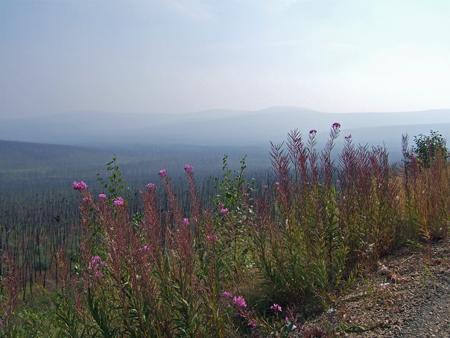 Smoky distant view |
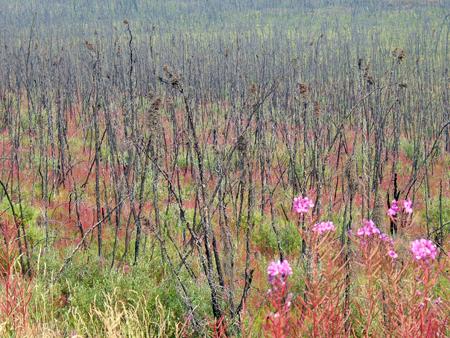 Charred forest with blanket of pink fireweed |
Chicken
to Dawson – Tuesday, August 4, 2009
We were up early for a guided tour of historical Chicken, the ghost town remains of the turn-of-the-century gold mining village, which was later taken over by a larger mining enterprise. If you’re a reader (as I am), Chicken was the setting for Tisha, the true story of a young Colorado teacher (with adventure on her mind) who came to Chicken in 1927 to teach the children. Thus, the highpoint for the tour was Tisha’s schoolhouse and living quarters.
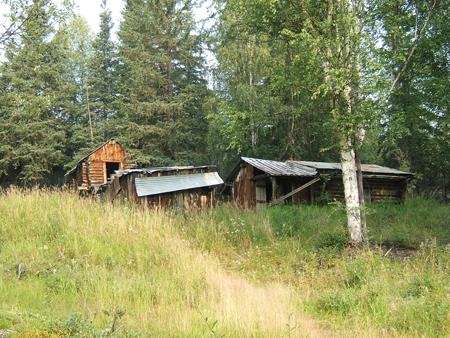 Tin-roofed remains from Chicken's past |
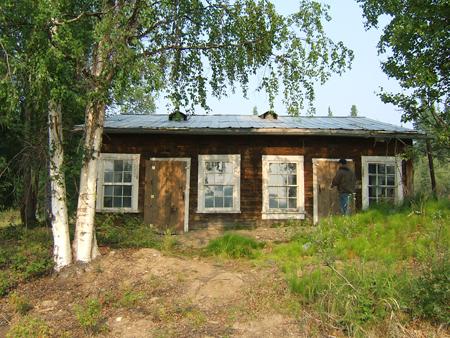 Tisha's schoolhouse and living quarters |
After the tour, we hit the road for Dawson. The trip was an adventure through smoke and haze on a bumpy, dusty gravel and dirt road. Crossing the international border at Boundary (where we lost an hour), roads in the Yukon improved, but it was a rough ride across the windy gravel Top of the World Highway. (Several things in the trailer rattled lose, and the glass tray in the microwave shattered) Unfortunately, any views were swallowed up by the smoky haze. The last segment, across the Yukon River into Dawson, was on a ferry named the George Black. We had to wait nearly an hour for our turn to cross.
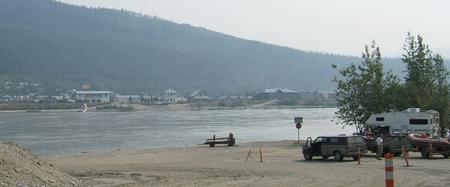 Waiting for the ferry |
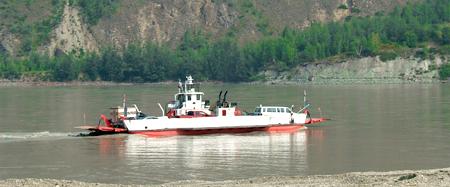 The George Black takes vehicles across the Yukon River |
Dawson, once a roaring gold town, remains a national historic site, and all the buildings must maintain the historic charm of yesteryear. The roads are still compressed, graded dirt, and the sidewalks wood-plank boardwalks. Unfortunately, the smoky skies lend a dismal atmosphere – a dry, barren space. Camped outside of town, we managed to drive back into town for a look-see and quick stop at the visitors’ center and grocery store.
Dawson –
Wednesday, August 5,2009
During our time in Dawson today, we explored a town lost in its historic past – the turn-of-the-nineteenth-century Klondike gold rush era. Gold was actually discovered outside of town on Bonanza Creek on August 17, 1896, and the population of Dawson soon swelled to 40,000. During its heyday, Dawson was second only to San Francisco. Its popularity was short-lived, as other discoveries throughout the Klondike and Alaska drew the gold seekers elsewhere.
First, we visited the Palace Grand Theatre, one of the businesses established to “mine” the gold from the pockets of the miners. We saw a short play, “Buckshot and Bloomers,” about the lives of saloon girls from that era, and then we watched an older film about the S.S. Keno, one of about 250 riverboats that once traveled the Yukon River. Finally, we went on an interesting tour of the town, with a guide in period costume who regaled us with legends and stories from the gold-rush era. After dinner, we visited Diamond Tooth Gertie’s, a period saloon/casino with an excellent floor show featuring cancan and tap dancers, and chanteuse Gertie’s songs.
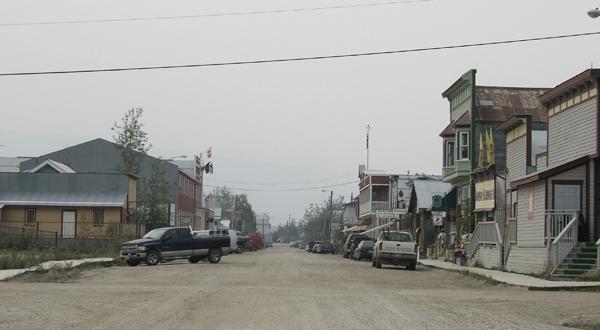 Downtown Dawson |
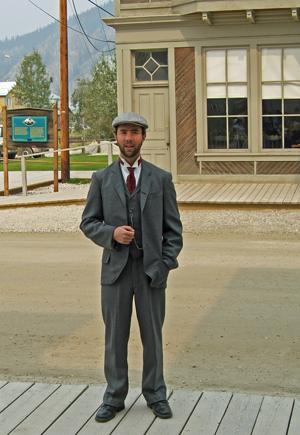 Costumed city guide |
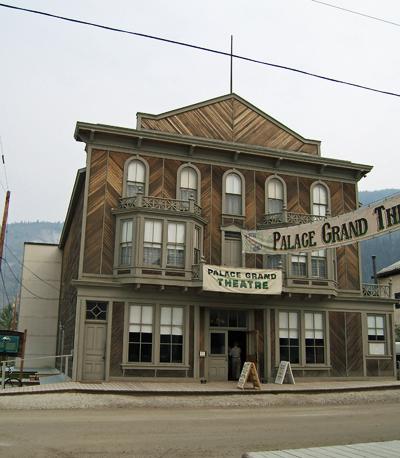 Palace Grand Theatre |
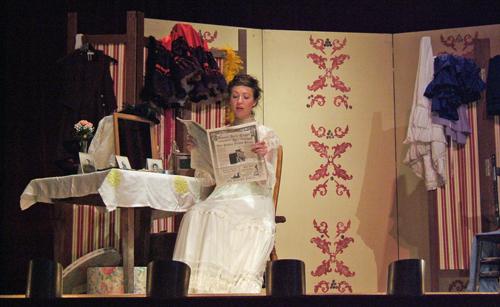 Actress in "Buckshot and Bloomers" |
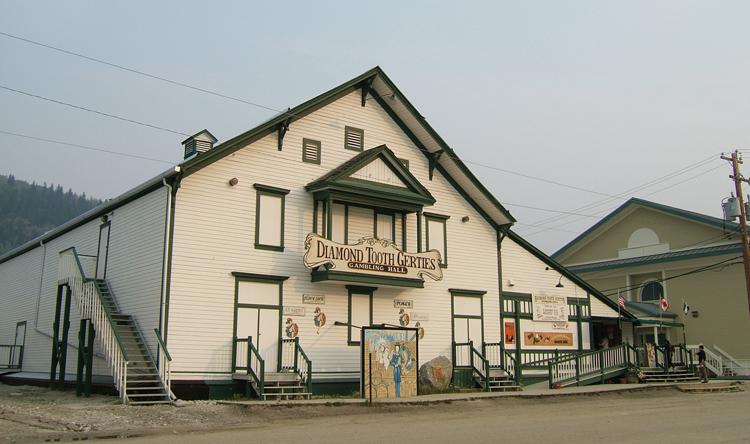 Diamond Tooth Gertie's |
Dawson –
Thursday, August 6, 2009
This morning we drove the ten miles out to the original gold discovery site and visited Gold Dredge Number 4. Once individual miners moved on to other places, mining companies came into the area to unearth remaining gold. Gold in this area is placer gold and not found in deep veins, so the chosen method for its extraction was by dredges – huge barges that floated in ponds and dug up buckets of soil to be sluiced for removal of the gold.
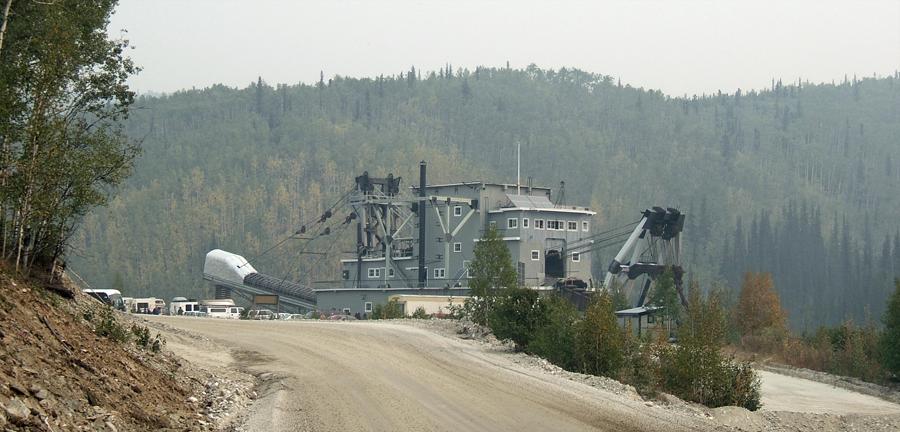 Dredge Number 4 |
This afternoon we took it easy. We drove into town, got gas, and headed up to Midnight Dome, a high point overlooking the city and the river. Unfortunately, this afternoon the winds shifted and the smoke came in really thick, so there wasn’t much view.
Dawson to
Whitehorse – Friday, August 7, 2009
This morning, we awoke to a dreary, smoked-in town. The sun was an orange ball behind the smoky haze. The smoke lightened as we drove south, but even in Pelly Crossing, where we made a short stop midmorning to go into a small cultural center, the smoke was a presence. The gal in the Selkirk Heritage Centre told us smoke is common in July and August.
After lunching beside the Yukon, which we followed for most of the day, we pulled into Carmacks early afternoon and took a break to visit the Tage Cho Hudan Interpretive Centre, another First Nations’ (as Canadian Indians are known) heritage center. That stop proved “memorable,” for, as we left the parking lot, Tom sideswiped a stump next to the dirt driveway. That “accident” damaged a tire rim necessitating a tire change and pleated the trailer stairs.
The rest of the drive was uneventful, but the time added to an already-long day, and it was about 6 p.m. when we pulled into Whitehorse. Although cloudier and cooler than when we came through on our drive north, Whitehorse is, thankfully, minus the heavy smoke-scented air of the northern Yukon. Tired and hungry, we returned to Boston Pizza for another good meal.
Whitehorse – Saturday, August 8, 2009
This morning I did laundry. I always enjoy conversing with other travelers in the laundry room. This time, I visited with a gal from Albuquerque and one from Ocala, Florida. (Made me think of you, Karen Holgate. She said it was the only hilly part of Florida and beautiful.) While I did laundry, Tom cleaned the trailer, fixed the trailer steps, and partially fixed a leaky pipe we’ve had.
After lunch, we headed out to run some errands – get a new tire rim, go to Wal-Mart, and visit a couple of grocery stores. I have been disappointed by grocery stores in the far north. (Or maybe I am just a spoiled Californian?) The selection is not as good, nor is the produce. Plus, I miss some of the “health” foods and smaller packaging I am used to buying. I think with the weather and distance factor, many up here buy in bulk and appreciate the larger quantities, which are less than ideal for two people in a trailer without a lot of storage.